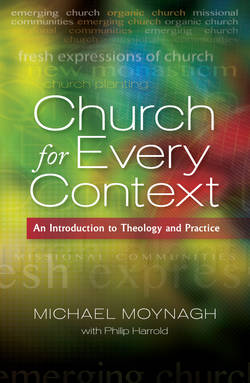Читать книгу Church for Every Context - Michael Moynagh - Страница 66
На сайте Литреса книга снята с продажи.
Growing dis-ease with church
ОглавлениеAccording to Goldstein, Hazy and Silberstang, disequilibrium typically begins with a growing realization that ‘business as usual’ does not work (2010, p. 105). In the British church, this realization – though by no means new – built up steam during the 1990s and intensified in the 2000s. There was mounting interest in how church should respond to the postmodern world, books such as Michael Riddell’s Threshold of the Future, published in 1998, and later blogs were highly critical of the existing church, and the emerging church conversation had growing influence.
In addition was the stark evidence that church attendance was in decline. Many congregations and clergy could see this in their own churches and experienced the consequences in repeated cycles of reorganization, designed to maintain the church in the face of falling clergy numbers. Christian Research reported that average Sunday attendance in England had fallen from 11.7 per cent of the population in 1979 to 7.5 per cent in 1998. The drop among young people was especially dramatic. Brierley suggested that if the current rate of decline continued the percentage going to church in 2016 would be 0.9 per cent. The church would have ‘bled to death’ (Brierley, 2000b, pp. 27–8).5 Though the rate slowed in the early 2000s, the percentage attending church in 2005 was down to 6.3 per cent (Brierley, 2006, p. 20).
According to an extensive Tearfund survey, in 2007 a quarter of UK adults went to church once a year or more – 15 per cent once a month. Among the remainder, 6 per cent belonged to other faiths; 32 per cent had never been to church (except for baptisms, weddings and funerals) and expressed little inclination to go in the future (the ‘closed unchurched’); 28 per cent attended church in the past, had stopped doing so and were not very or at all likely to go in the future (the ‘closed dechurched’). Thus two-thirds of the population appeared most unlikely to attend church on current trends. Only 6 per cent of the survey said they did not go to church but were very or fairly likely to do so (Ashworth, Research Matters and Farthing, 2007, pp. 5–7). This set out clearly the scale of the mission task in Britain.
More poignant were the experiences of many churchgoers themselves. The phenomenon of church leaving came firmly on to the agenda. Francis and Richter reported that nearly half of all church leavers found it increasingly hard to believe, did not feel part of the church, disliked the hypocrisy they saw in other churchgoers and claimed that church failed to connect with the rest of their lives. Around two-fifths said that their participation in church had become a chore, they found church boring and they were not interested in the activities on offer. Three-quarters believed that they did not need to go to church to be a Christian (Francis and Richter, 2007, pp. 318–32).
Many of the touted strategies to promote church growth seemed to bear limited fruit. Among evangelicals especially, power evangelism, seeker services, the purpose-driven church and other models appeared to work in relatively few cases. Two notable ‘successes’ were the Alpha course and church planting-at-scale particularly by Holy Trinity, Brompton in London (HTB). Other churches, however, found that the HTB church planting model demanded too many resources and that Alpha often yielded diminishing returns: numbers fell when the course was repeated.
